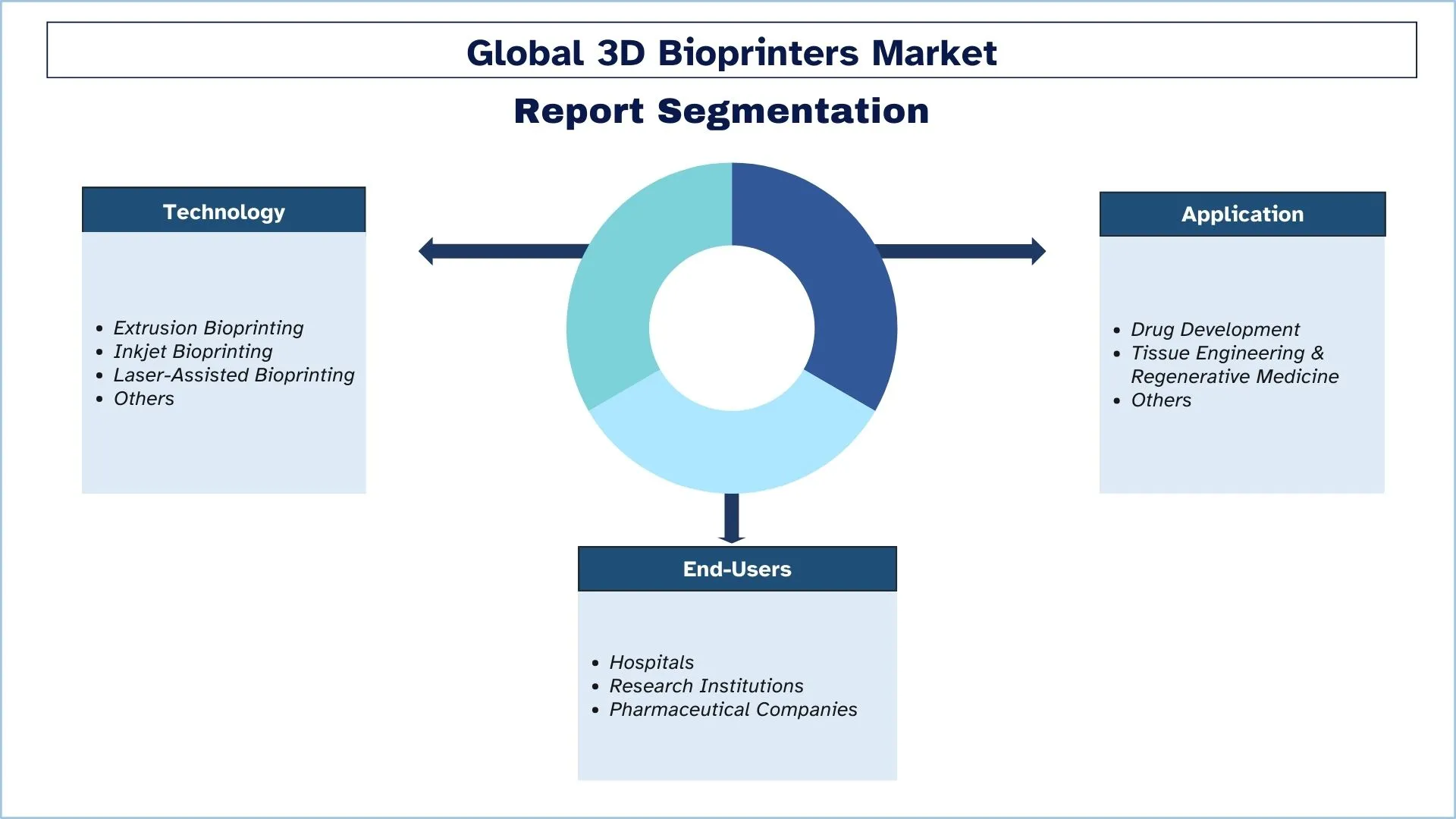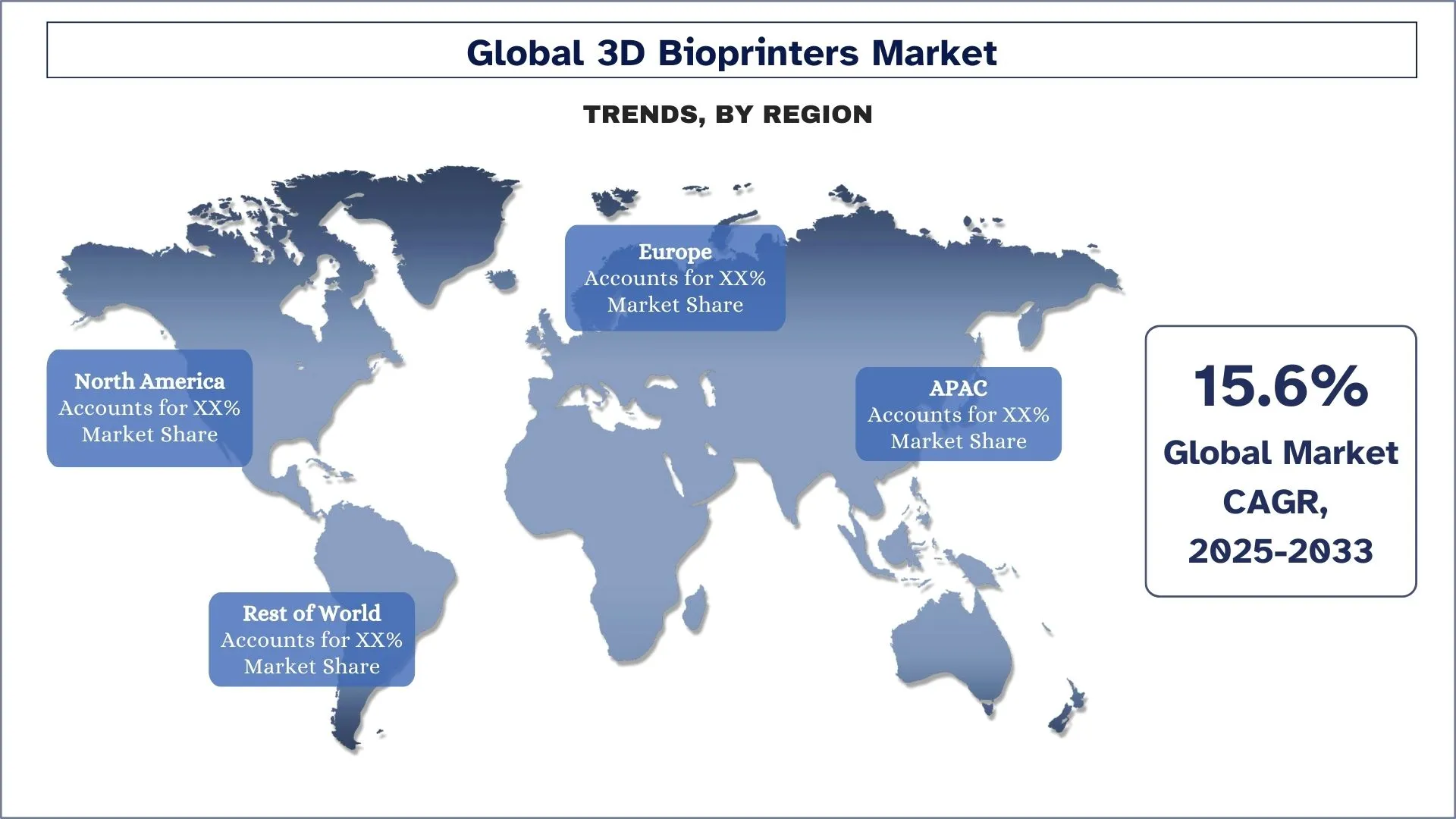- Home
- About Us
- Industry
- Services
- Reading
- Contact Us
3D Bioprinters Market: Current Analysis and Forecast (2025-2033)
Emphasis on Technology (Extrusion Bioprinting, Inkjet Bioprinting, Laser-Assisted Bioprinting, and Others); Application (Drug Development, Tissue Engineering & Regenerative Medicine, and Others); and End-Users (Hospitals, Research Institutions, and Pharmaceutical Companies); and Region/Country

3D Bioprinters Market Size & Forecast
The 3D Bioprinters market was valued at approximately USD 1.4 billion in 2024 and is expected to grow at a substantial CAGR of around 15.6% during the forecast period (2025-2033), owing to the growing demand for personalized medicine.
3D Bioprinters Market Analysis
The global 3D bioprinters market is witnessing rapid expansion, with North America, Europe, and the Asia Pacific leading the charge. The market is segmented based on technology, end-users, and applications, showcasing the diverse range of possibilities offered by 3D bioprinting. Innovations in bioprinting technologies, such as extrusion, inkjet, and laser-assisted bioprinting, have opened avenues for the precise fabrication of complex tissues and organ constructs. The 3D bioprinters market is experiencing remarkable growth and transformation, driven by breakthroughs in tissue engineering, regenerative medicine, and drug development. As the demand for personalized healthcare solutions and organ transplantation alternatives rises, 3D bioprinting technology emerges as a game-changer in the medical field.
Emulate, a biotech company, introduced liver-on-a-chip, a 3D bioprinted miniaturized human liver model on a microfluidic platform. This advancement allows for more accurate and efficient drug testing, reducing the reliance on animal models. 3D Systems and Stratasys are leading the charge in creating personalized implants and prosthetics using biocompatible materials and advanced 3D bioprinting techniques. These custom-made implants enhance patient outcomes and improve overall quality of life.
3D Bioprinters Market Trends
This section discusses the key market trends influencing the various segments of the 3D Bioprinters market as identified by our research experts.
Integration of AI and Automation in 3D Bioprinting
A major market development in 3D bioprinting includes the implementation of artificial intelligence alongside automated systems for enhancing precision and reproducibility while determining efficiency. The combination of AI-powered system technologies allows real-time operability and adaptive printing to reduce mistakes and produce superior printed biological structures. The combination of automated systems and machine learning programs shortens complex procedures from bio-ink preparation until tissue maturity, advancing research activities in tissue engineering and drug testing, as well as regenerative medicine. Multiple technological trends are making 3D bioprinting an improved, scalable, and commercially practical solution for next-generation healthcare development.
3D Bioprinters Industry Segmentation
This section provides an analysis of the key trends in each segment of the global 3D bioprinters market report, along with forecasts at the global, regional, and country levels for 2025-2033.
The Tissue Engineering & Regenerative Medicine Market Holds the Largest Share of the 3D Bioprinters Market.
By application, the market is segmented into drug development, tissue engineering & regenerative medicine, and others. Among these, tissue engineering & regenerative medicine market captured the majority share of the 3D Bioprinters market in 2024. Tissue engineering and regenerative medicine offer a promising solution to the shortage of donor organs for transplantation. Bioprinting enables the creation of patient-specific tissues and organs using the patient's cells, reducing the risk of rejection and eliminating the need for traditional organ donors.
The Hospitals Segment is Expected to Witness a Higher CAGR than the 3D Bioprinters Market.
Based on end users, the market is segmented into hospitals, research institutions, and pharmaceutical companies. Research institutions are essential drivers of innovation in the bioprinting field. They focus on advancing the understanding of tissue engineering, regenerative medicine, and disease modeling. By pushing the boundaries of 3D bioprinting research, these institutions can lead in developing new bioprinting techniques, materials, and applications.

North America has a significant share of the market in 2024.
North America dominated the 3D Bioprinters market in 2024. North America was expected to continue growing in the 3D bioprinters market due to several factors that created a conducive environment for the adoption and advancement of this technology. Researchers and companies in North America made advancements in bioprinting complex organs for transplantation. The development of functional heart tissue and liver constructs demonstrated the potential for personalized organ transplants. Biotech companies and research institutions in the region explored the use of 3D bioprinted tissues for preclinical drug testing, aiming to improve drug development processes and reduce reliance on animal testing.
U.S. Dominates the North American 3D Bioprinters Market
The U.S. 3D bioprinters market is also in its growing stage due to its proliferation in the fields of regenerative medicine, personalized healthcare, and tissue engineering. There is growing utilization in organ and tissue manufacturing due to the scarcity of these and the rising cases of chronic ailments. Advancements in bio-inks, cell-scaffold composites, and high-resolution bioprinting instruments are leading to coordinated three-dimensional structures with improved functionality. Also, there is active cooperation between biotech companies, research centers, and clinical care organizations that encourages new technologies and applications. It shows that as the market evolves, one of the critical factors in adopting bioprinted solutions in the clinics is the necessity for specific legal regulation and developing standards.

3D Bioprinters Industry Competitive Landscape
The 3D Bioprinters market is competitive, with several global and international players. The key players are adopting different growth strategies to enhance their market presence, such as partnerships, agreements, collaborations, new product launches, geographical expansions, and mergers and acquisitions.
Top 3D Bioprinters Companies
Some of the major players operating in the market are Organovo Holdings Inc.; BICO; Stratasys; CYFUSE BIOMEDICAL K.K.; REGEMAT 3D SL; Allevi Inc.; Inventia Life Science; Envisiontec US LLC (Desktop Metal); ROKIT HEALTHCARE INC.; GeSim
Recent Developments in the 3D Bioprinters Market
- In February 2024, BICO Group AB (Cellink) launched DNA Studio 4 Vault, a bioprinting software, providing users with confidence and trust in their documentation, enabling a faster translation from the research lab to the clinic.
- In February 2024, Merck KGaA (Germany) established a distribution center in Brazil with an investment of USD 21.7 million to better serve its Life Science customers for faster deliveries in the region.
3D Bioprinters Market Report Coverage
Details | |
Base year | 2024 |
Forecast period | 2025-2033 |
Growth momentum | Accelerate at a CAGR of 15.6% |
Market size 2024 | USD 1.4 Billion |
Regional analysis | North America, Europe, Asia-Pacific, Rest of the World |
Major contributing region | North America is expected to grow at the highest CAGR during the forecasted period. |
Key countries covered | U.S., Canada, Germany, France, UK, Spain, Italy, China, Japan, and India |
Organovo Holdings Inc.; BICO; Stratasys; CYFUSE BIOMEDICAL K.K.; REGEMAT 3D SL; Allevi Inc.; Inventia Life Science; Envisiontec US LLC (Desktop Metal); ROKIT HEALTHCARE INC.; GeSim | |
Report Scope | Market Trends, Drivers, and Restraints; Revenue Estimation and Forecast; Segmentation Analysis; Demand and Supply Side Analysis; Competitive Landscape; Company Profiling |
Segments Covered | By Technology, By Application, By End-Users, By Region/Country |
Reasons to Buy the 3D Bioprinters Market Report:
- The study includes market sizing and forecasting analysis validated by authenticated key industry experts.
- The report presents a quick review of overall industry performance at a glance.
- The report covers an in-depth analysis of prominent industry peers with a primary focus on key business financials, product portfolios, expansion strategies, and recent developments.
- Detailed examination of drivers, restraints, key trends, and opportunities prevailing in the industry.
- The study comprehensively covers the market across different segments.
- Deep dive regional-level analysis of the industry.
Customization Options:
The global 3D Bioprinters market can be customized further as per the requirement or any other market segment. Besides this, UnivDatos understands that you may have your own business needs; hence, feel free to contact us to get a report that completely suits your requirements.
Table of Content
Research Methodology for the 3D Bioprinters Market Analysis (2023-2033)
We analyzed the historical market, estimated the current market, and forecasted the future market of the global 3D Bioprinters market to assess its application in major regions worldwide. We conducted exhaustive secondary research to gather historical market data and estimate the current market size. To validate these insights, we carefully reviewed numerous findings and assumptions. Additionally, we conducted in-depth primary interviews with industry experts across the 3D Bioprinters value chain. After validating market figures through these interviews, we used top-down and bottom-up approaches to forecast the overall market size. We then employed market breakdown and data triangulation methods to estimate and analyze the market size of industry segments and sub-segments.
Market Engineering
We employed data triangulation techniques to finalize the overall market estimation and derive precise statistical numbers for each segment and sub-segment of the global 3D Bioprinters market. We split the data into several segments and sub-segments by analyzing various parameters and trends, including technology, application, end-users, and regions within the global 3D Bioprinters market.
The main objective of the Global 3D Bioprinters Market Study is to
The study identifies current and future trends in the global 3D Bioprinters market, providing strategic insights for investors. It highlights regional market attractiveness, enabling industry participants to tap into untapped markets and gain a first-mover advantage. Other quantitative goals of the studies include:
- Market Size Analysis: Assess the current and forecast market size of the global 3D Bioprinters market and its segments in terms of value (USD).
- 3D Bioprinters Market Segmentation: The study segments the market by technology, application, end-users, and region.
- Regulatory Framework & Value Chain Analysis: Examine the regulatory framework, value chain, customer behavior, and competitive landscape of the 3D Bioprinters industry.
- Regional Analysis: Conduct detailed regional analysis for key areas such as Asia Pacific, Europe, North America, and the Rest of the World.
- Company Profiles & Growth Strategies: Company profiles of the 3D Bioprinters market and the growth strategies adopted by the market leaders to sustain the fast-growing market.
Frequently Asked Questions FAQs
Q1: What is the 3D Bioprinters market's current size and growth potential?
As of 2024, the global 3D bioprinters market is valued at approximately USD 1.4 billion and is expected to grow at a CAGR of 15.6% through 2033, driven by technological advancements and increasing healthcare applications.
Q2: What are the driving factors for the growth of the 3D Bioprinters market?
The growing demand for personalized medicine and tissue engineering is propelling the adoption of 3D bioprinters, enabling the precise fabrication of human tissues and organ models.
Q3: Which segment has the largest share of the 3D Bioprinters market by end-users?
The Hospitals segment currently holds the largest market share by the end-users segment.
Q4: What are the major trends in the 3D Bioprinters market?
Integration of AI and advanced biomaterials with 3D bioprinting technology is enhancing printing precision, scalability, and application in regenerative medicine and pharmaceutical research.
Q5: Which region will dominate the 3D bioprinters market?
North America leads the global 3D Bioprinters market.
Q6: What are the biggest challenges in the 3D Bioprinters market?
High costs, regulatory hurdles, and limited standardization in bio-ink formulations continue to restrict widespread commercial adoption and scalability of 3D bioprinting solutions.
Q7: Who are the Top players in the global 3D Bioprinters market?
The leading companies driving innovation in 3D Bioprinters include:
• Organovo Holdings Inc.
• BICO
• Stratasys
• CYFUSE BIOMEDICAL K.K.
• REGEMAT 3D SL
• Allevi Inc. (3D Systems)
• Inventia Life Science
• Envisiontec US LLC (Desktop Metal)
• ROKIT HEALTHCARE INC.
• GeSim
Q8: What are the key investment opportunities in the U.S. 3D bioprinters market?
Investment opportunities lie in advanced bioprinter technologies, scalable bio-ink solutions, and partnerships focused on regenerative medicine, organ-on-chip models, and pharmaceutical testing. Early investments in R&D and IP development offer long-term strategic value.
Q9: How can companies gain a competitive edge in the evolving 3D bioprinting landscape?
To stay competitive, companies should prioritize innovation, secure strategic collaborations with research institutions, focus on regulatory readiness, and invest in scalable manufacturing and customization capabilities.
Related Reports
Customers who bought this item also bought










